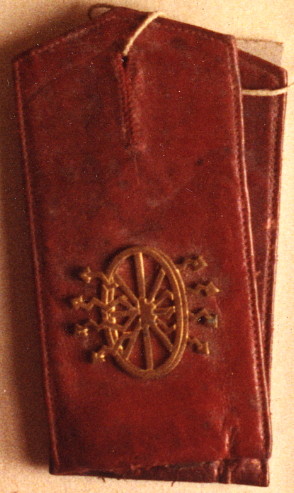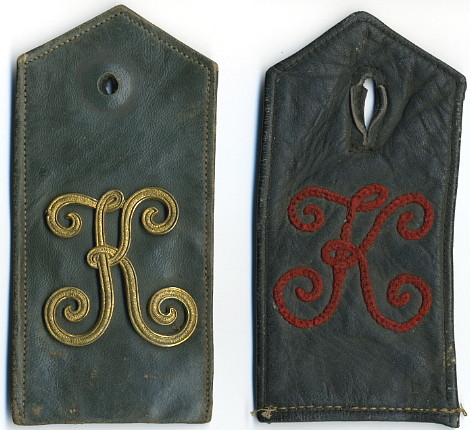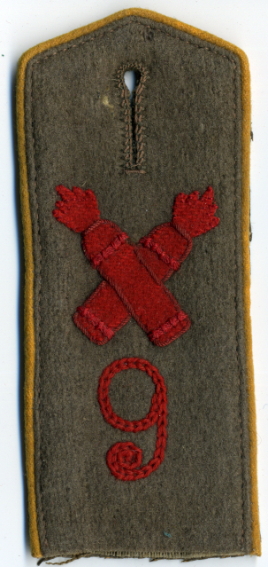-
Posts
2,962 -
Joined
-
Last visited
Content Type
Profiles
Forums
Blogs
Gallery
Events
Store
Posts posted by Chip
-
-
Here's the head stamp on my Austrian mountain gun cartridge case. At the bottom it says, "7,5 cm M15". The manufacturer is Berndorf. Both the case and the fuse are dated 1917. Hope you can see it well enough.
Chip
 0
0 -
Super items. Thanks for the further information.
Chip
0 -
Stefan,
Very unusual indeed. To what factors do you attribute the fact that the buckle body is in such different condition than the roundel insignia? Would you show the reverse side?
Respectfully,
Chip
0 -
Andreas,
I don't know if those with civilian driver's licenses were just handed a military license. I would think they would have to have training on military vehicles before they could be allowed to drive them. Perhaps some, like the former members of the Kaiserliches Freiwilliges Automobil-Korps got a pass, as they were equivalent to officers and had been driving for the military for some time before they were inducted into the Kraftfahrkorps.
Chip
0 -
I believe it is a button from the uniformed household staff (livery) of the Prussian royal house. So, people like footmen, butlers, batmen, etc.from any of a number of residences.
Chip
0 -
Just as an added note....the Lederlitewka came with and without the automobile collar device, the difference being that the ones with the device indicated that the wearer had earned his military Führerschein (driver's license).
Chip
0 -
Exceptionally, nice! Still looking for my first. I'm running out of time.....
 0
0 -
Hardy,
Here are the three types. First, the M1907 leather strap for the black Lederlitewka (from the collection of the Bavarian Army Museum). It was red leather with a black leather underside. The device was a brass wheel with lightening bolts. This was replaced in 1911 with a brass "K" on a black leather strap. In the spring of 1916, the brass "K" was replaced by a red chainstiched letter "K". You can't really date a wartime photo by the brass "K" alone, as the ones already in use in 1916 continued to be worn until the end of the war.
Chip

 0
0 -
I wonder if any of our uniform guys have Feldgrau sailors' outfits from the "dirt navy?"
I have a few things, including a navy marked Drillich outfit (jacket and trousers), a navy rucksack, a blue cap with tally from the 2.Matrosen Regiment, a white canvas work jumper and some sleeve ratings on gray cotton. I've been looking for an enlisted gray cotton cap for decades, but have never had the chance to get one.
0 -
Though I typically don't comment on such lovely headgear (I have no expertise), I do very much admire the fine pieces that you show us. Most of these rarities are never seen by the average collector over a lifetime of collecting. Thanks for your efforts to produce such detailed photographs for us all to enjoy.
Chip
0 -
Paul,
Regarding shoulder boards, the color of the underlay has nothing to do with the state. The colors, depending on the model, can indicate a corps color, a traditional regimental facing color or a branch color. The state is normally indicated by the color of the darts (Faden) or threads in the cording. Green or green/white would be for Saxony, blue or blue/white for Bavarian and so forth. In the case of the RIR.263 the color of the underlay is red because the unit was formed in the IV.Armee Korps, which had red for the corps color. The color of the darts are black, indicating that the unit is Prussian.
Chip
0 -
Chris,
With those boards, he would have to have been promoted during the first year of the war.
Chip
0 -
Chris,
These are the early pattern subdued boards. He must have been promoted early on, as the unit was formed at the end of 1914 and this pattern was replaced (on paper at least) with the 9/21/1915 regulations. Very nice!
Chip
0 -
Marcin,
That is a nice little grouping! I will try to answer your questions. These shoulder boards could have been worn by any enlisted/NCO rank. There is no distinction. We hesitate to put a model name with these boards, as most were worn for many years, going back to the Franco Prussian War and beyond. If you have to put a name to them, I would call them shoulder boards for the Dunkelblau Waffenrock. Some people call them M1895, as this was the date that the old blue uniforms were replaced with an updated model. The shoulder boards did not have any noticeable changes, however.
The black/dark blue shoulder board is from an old pattern 1892 pattern blue/black Litewka. The shoulder boards were of the same material as the Litewka and were without piping. They had yellow numbers or cyphers. These were replaced in 1900, when a new gray Litewka was introduced and which carried shoulder straps in full color as on the Waffenrock.
What is the backing material on the white 167 strap?
Chip
0 -
Thanks everyone for your help and insights. Much appreciated.
Chip
0 -
A friend has a tunic that is named to Hauptmann Franz Geßlein. There are three loops on the chest for badges and loops for a medal bar of approximately five ribbons. Can anyone steer him toward an answer regarding what might have been worn by this officer? Here is what we know so far.
Geßlein was promoted to Hauptmann 11 March 1911. The tunic's tailor was located in Würtzburg and Geßlein was in the 9th Bavarian Infantry Regiment garrisoned in Würtzburg. He was promoted to Major 14 December 1917. He was born in 1873 and was 44 years old at this time. The tailor's label is dated 1917. He survived the war and was still in active service in
1926.Thanks in advance,
Chip
0 -
'Stettin' that's what I don't get aren't these Bavarian buttons, you think the collar id belongs or just been added?
Eric
Eric,
I see extra prong holes in the enlarged picture of the collar. The "7s" are not of the normal Landsturm number pattern. The devices may be period, but as you know, the Bavarian units wore a "B" on their collars as of April of 1915. The marking inside is to the training battalion of the b.RIR2 and B.A.I., which doesn't really jive with the insignia.
Chip
0 -
Super helmet. I can't imagine a guy having that helmet would be much inclined to negotiate. Where are you going to get another one?

Chip
0 -
These early war issue tunics (pre-Bluse) have always been tough to find, but especially today. Compared to the numbers of private purchase tunics and Bluse, finding one is like finding the Hope Diamond. The overwhelming majority of this pattern tunic were either worn out in the field or buried with their wearer.
Chip
0 -
Rick,
We seem to get mostly combat related items here. I've never owned a personalized sword myself, primarily due to the usually inflated cost of such things, but also because I tend to prefer issue enlisted items.

Chip
0 -
Adler1,
Here is an example of what I was talking about. M07 foot artillery straps had white piping. M15 foot artillery straps were all yellow. So, this is some tailor's idea at what to do with the straps on a tunic that has buttons down the front, but is made after the new regulations of 1915. In my estimation, these were made specifically for walking-out-dress and that is why they survived the war. I've seen these hybrids in foot artillery, field artillery, pioneers and some cavalry unit's straps.
Chip
 0
0 -
Well, I have to admit that the memories last 50 years of collecting are starting to get somewhat gemischt.
 0
0 -
Marcin,
As I understand it, the recruits received basic training in Germany. The time varied in length as the war progressed and events in the field caused these periods to be truncated. At Beverloo, one could get further basic training, trench warfare training, as well as other specialized training courses. From Beverloo, infantry troops could be sent to any field unit that needed new drafts. It could be a line regiment, a reserve regiment, a Landwehr regiment, etc..
Chip
0 -
Wow! The prices on these have gone through the roof! It wasn't all that long ago that you could still buy them for under $100. I'm surprised, with all the fakes that are out there, that the price has not come down. Quite often, when items become heavily faked, you can find some bargains if you know what you are doing.
Chip
0




Leutnant d.R. Kessler
in Germany: Imperial: Rick (Research) Lundstrom Forum for Documentation and Photographs
Posted
My source gives the FAR's regimental affiliation with the 29.Landwehr Brigade, which in the fall of 1917 became the 29.Landwehr Division. The 29th spent the entire war on the Eastern front.
Chip